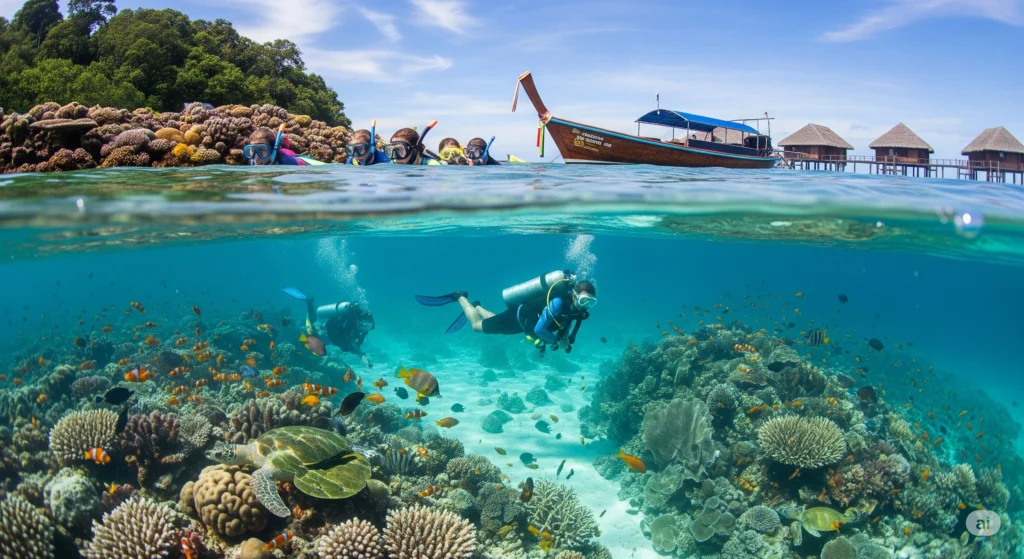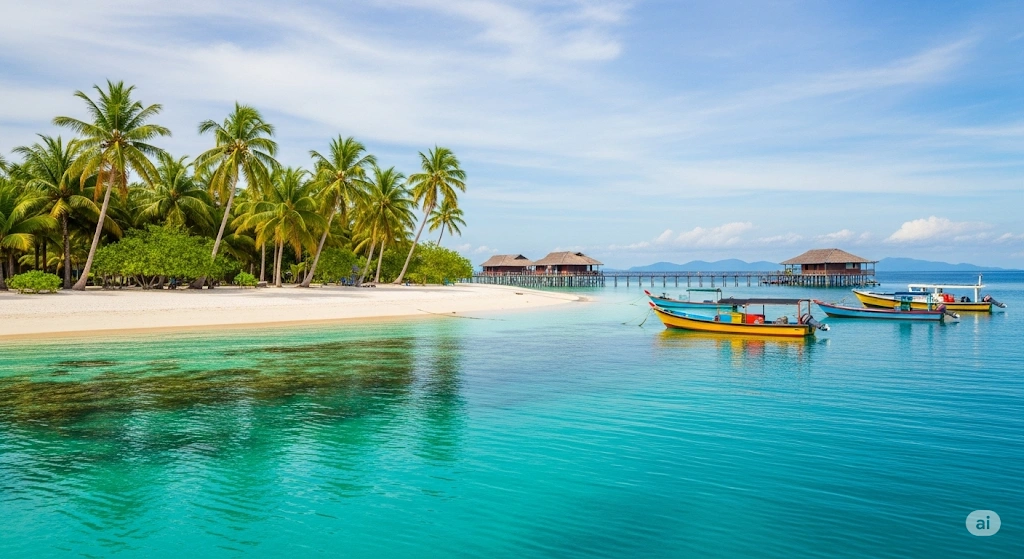MyTrip to Borneo Paradise Mabul Island
If you’re looking for a tropical escape that goes far beyond a generic beach holiday, Mabul Island is your answer. Tucked away in the Celebes Sea off the southeastern coast of Sabah, Malaysian Borneo, this enchanting island offers a rare blend of world-class diving and authentic cultural immersion. It’s a place where the rhythm of life is set by the tides, and the warmth of the local community is as vibrant as the underwater world.
Some divers call Mabul the “Underwater Critter Capital of the World” because of its unmatched variety of small marine species.
This comprehensive handbook is designed to be your essential guide to Mabul, covering everything from the island’s unique history and travel logistics to the best dive sites, accommodation options, and cultural experiences.
A Brief History of Mabul and the Sipadan Connection
Before it became a diving mecca, Mabul was a simple fishing village, home to the nomadic Bajau Laut, also known as “sea gypsies.” These master free divers have a deep, generations-long connection to the ocean, living in stilted homes and traveling in traditional wooden boats called lepa. The island’s destiny changed in the 1980s when the legendary explorer Jacques Cousteau brought global attention to its neighbor, Sipadan Island, describing it as “an untouched piece of art.”
Divers flocked to Sipadan, but the increased tourism took a toll on the delicate reef ecosystem. In 2004, a conservation order by the Malaysian government closed all resorts on Sipadan, and most dive operators relocated to Mabul, just a 25-minute boat ride away. This move transformed Mabul from a quiet fishing community into a thriving dive destination in its own right, celebrated for its unique “muck diving” opportunities.
Unknown Facts About Mabul Island
- Originally a Fishing Village: Before becoming famous for diving, Mabul was just a quiet fishing village inhabited by the Bajau Laut (Sea Gypsies). Tourism only picked up in the 1990s after Sipadan was declared a protected marine park.
- One of the Best Macro Diving Spots in the World: Unlike Sipadan (known for big pelagics), Mabul is a “muck diving” paradise. Divers come here to spot rare critters like flamboyant cuttlefish, blue-ringed octopus, ghost pipefish, frogfish, and nudibranchs.
- The Sea Gypsies Live in Stilt Villages: The Bajau Laut community lives in wooden stilt houses built over the sea. Many families don’t have official citizenship, schools, or healthcare access, yet they’ve lived here for generations relying on fishing.
- Artificial Reefs from Old Boats: To protect marine life, old boats and structures have been deliberately sunk around Mabul to create artificial reefs, which now attract a rich variety of marine creatures.
- Night Diving is a Hidden Gem: Mabul’s underwater world transforms at night. You can witness hunting octopuses, cuttlefish changing colors, and rare nocturnal species that you won’t see during the day.
- Small but Diverse: The island is only about 20 hectares (roughly 500m by 200m), but it’s home to luxury resorts, local villages, and dive centers—packed into a very small footprint.
- Not Just Diving – Unique Village Life: Visitors can explore the local village, where kids often paddle in handmade boats or even floating containers. Their lifestyle is simple yet fascinating to observe.
- Accessible Only by Boat: You can’t fly or drive directly to Mabul. The nearest airport is in Tawau, from where travelers head to Semporna and then take a boat (about 45 minutes).
- Turtle Sightings are Common: While Sipadan is the turtle capital, Mabul also has a surprising number of green turtles and hawksbill turtles around its reefs.
- Future at Risk: The island faces challenges like overfishing, waste management, and unregulated tourism. Conservation efforts are ongoing, but the balance between tourism and protecting local life is delicate.
Getting to Your Island Paradise
Your journey to Mabul is an adventure in itself, starting with a flight into Tawau Airport (TWU) from major Malaysian hubs like Kuala Lumpur (KUL) or Kota Kinabalu (BKI).
Step 1: Fly to Tawau Airport (TWU)
Tawau Airport is the main gateway to the Semporna Islands.
Step 2: Land Transfer to Semporna
From the airport, it’s a scenic 90-minute drive to the coastal town of Semporna, the main launch point for all the islands.
Private Taxi: Expect to pay around MYR 150.
Shared Van: A more budget-friendly option, often arranged by your hotel or dive shop for about MYR 50 per person.Step 3: Boat Transfer to Mabul
Boats typically depart from Semporna jetty in the mornings. The journey to Mabul takes approximately one hour and is often included in your dive and accommodation package. If not, a one-way trip costs around MYR 100.
Travel Tip: Many visitors spend a night in Semporna before heading to Mabul. Good, clean budget options like Cube Bed Station Hostel or Amazing Cafe & Lodge are perfect for a short stay and are located near the pier.
Where to Stay on Mabul Island
Mabul’s accommodations cater to a wide range of budgets, from luxurious overwater bungalows to rustic backpacker lodges. Choosing a dive + stay package is highly recommended as it’s the most cost-effective way to experience the island.
Luxury Dive Resorts
These resorts offer stunning aesthetics, excellent amenities, and direct access to prime diving spots.
- Sipadan Water Village: Famous for its overwater chalets, this resort provides a truly luxurious and romantic experience.
- Seaventures Dive Rig: A bucket-list experience for divers. This converted oil rig offers unlimited house reef diving and a unique, adventurous atmosphere.
- Borneo Divers Mabul Resort: Features beach chalets, a swimming pool, and a long jetty perfect for sunset views.
Budget-Friendly Dive Lodges
For those who prioritize diving and cultural experience over luxury, these lodges are an ideal choice.
- Mabul Backpackers: Known for its low-cost packages, communal dining, and breathtaking sea views. This is where you’ll find a lively, international community of divers.
- Uncle Chang’s Dive Lodge: An iconic and long-established operator, offering simple stilted cottages and a fun, social vibe.
- Scuba Junkie: A reputable and slightly more upscale backpacker option with a strong focus on professionalism and marine conservation.
- Sphere Divers Scuba & Leisure: Located next to Uncle Chang’s, this lodge is another great, affordable choice with a laid-back feel.
Pro-Tip: Contact your chosen hotel or dive lodge directly via WhatsApp or email to inquire about all-inclusive dive packages. These bundles are almost always cheaper than booking your stay and dives separately.
The Best Time to Visit
The prime time for visiting Mabul Island and for diving is during the dry season, from March to October. During this period, you can expect calm seas and excellent underwater visibility. The monsoon season from November to February brings heavier rainfall and can affect visibility, but diving is still possible.
What to Do
Mabul Island is a small, idyllic island located off the southeastern coast of Sabah, Malaysia. Known for its beautiful beaches and vibrant marine life, it’s a popular destination, especially for divers. Here’s a breakdown of what you can do in Mabul:
Water Activities (The Main Attraction)

- Diving and Snorkeling: This is the primary reason people visit Mabul. The island is famous for “muck diving,” where you explore sandy or silty seabeds to find small, unusual, and fascinating marine creatures. You can spot a variety of critters like flamboyant cuttlefish, mimic octopuses, frogfish, nudibranchs, and more. While Mabul is a macro-diver’s paradise, you’ll also find bigger marine life like sea turtles, reef sharks, and rays. Many resorts offer unlimited dives from their house reefs.
- Island Hopping: Mabul is a great base for exploring nearby islands. You can take day trips to:
- Sipadan Island: A world-renowned dive destination, Sipadan is famous for its large schools of fish, barracuda “tornadoes,” sharks, and an abundance of turtles. Note that permits are required to dive or snorkel here, and they are limited.
- Kapalai Island: Located just 15 minutes by speedboat from Mabul, Kapalai is a sandbar with an overwater resort. It’s another excellent spot for snorkeling and diving.
- Tun Sakaran Marine Park: This marine park encompasses eight islands and two reefs, offering a range of snorkeling and diving opportunities.
- Kayaking: You can rent a kayak, sometimes a transparent one, to paddle around the calm, clear waters and explore the island’s coastline.
Exploring the Island
- Visit a Bajau Laut (Sea Gypsies) Village: Mabul is home to two villages of the indigenous Bajau Laut and Suluk tribes, often referred to as “sea gypsies.” You can take a walk around the stilt villages to witness their unique way of life and interact with the friendly locals.
- Relax on the Beach: Mabul has beautiful white-sand beaches where you can simply relax, sunbathe, and enjoy the stunning turquoise waters.
- Catch the Sunset or Sunrise: The island’s location offers spectacular views of both sunrise and sunset. The technicolor skies are a photographer’s dream.
Other Activities
- Indulge in Local Cuisine: Enjoy fresh seafood caught by local fishermen and prepared by talented chefs. You can often negotiate with passing boats to buy a variety of fresh seafood, from lobster to sea urchins.
- Get a Spa Treatment: Several resorts on the island offer spa and massage services for a relaxing break after a day of water adventures.
- Stargazing: With low light pollution, Mabul is an excellent spot for stargazing at night. The Milky Way is often visible.
Diving Mabul: A Macro Photographer’s Dream
While Sipadan is legendary for its large marine life like barracuda and sharks, Mabul is the world capital of muck diving. This unique form of diving focuses on searching for rare and bizarre creatures on sandy or silty bottoms. The experience is like an underwater treasure hunt.
- What you’ll find: Flamboyant cuttlefish, blue-ringed octopus, frogfish, ghost pipefish, countless species of nudibranchs, and various types of shrimp and crabs.
- Top Dive Sites:
- Paradise 1: A must-do. This site is renowned for its incredible density of unique critters, including baby seahorses and giant cuttlefish.
- Kapalai House Reef: Located near a nearby resort, this reef is teeming with life, from octopus to giant turtles.
- Lobster Wall: Although lobsters are rare now, the site offers fascinating corals and other small creatures.
Sipadan: To Dive or Not to Dive?
Sipadan is undeniably a diver’s pilgrimage site, famous for its dramatic drop-offs and “barracuda tornadoes.” However, diving here requires a special permit, which is limited to just 176 visitors per day.
- The Cons: Permits are expensive (MYR 400-500), hard to get, and require booking well in advance with a resort that has an allocation.
- The Pros: It’s a truly once-in-a-lifetime experience. If you have the time, money, and can secure a permit, it is worth it. Many resorts on Mabul will have a Sipadan diving package, but it often requires a minimum stay of 3-5 nights to have a chance at a permit.
For many divers, Mabul’s macro diving is just as, if not more, rewarding. It’s a different kind of magic.
Mabul Above the Water: Culture and Community
Mabul is more than just a diving hub. The island is a vibrant, living cultural village. Life here revolves around the Bajau Laut community, who live in stilted homes and maintain their traditional seafaring way of life.
- Fresh Seafood: A highlight of any trip is the daily seafood market. Each afternoon, local fishermen arrive by boat with their catch. You can bargain for fresh lobster, tuna, conch, or sea urchins and have it cooked by your guesthouse chef for a small fee. Fresh tuna sashimi is a particular treat!
- Village Life: Take a walk around the island’s single path. You’ll see children playing barefoot, men building boats, and women preparing meals. Locals are welcoming, but remember to be respectful—always ask permission before taking photos.
Safety and Practical Advice
While you may hear old stories of security issues in the region, the area is now heavily patrolled by coast guards and tourism remains a core part of the local economy. Visitors generally feel very safe.
- Currency: There are no ATMs on Mabul. Bring all the cash you need from Semporna.
- Connectivity: Wi-Fi is often limited and unreliable. For better connectivity, purchase a local SIM card in Semporna.
- Respect Local Customs: Dress modestly when walking through the village, particularly away from the resorts. The local community is predominantly Muslim.
- Eco-Conscious Travel: The island’s beauty is threatened by pollution. Be a responsible traveler by bringing a reusable water bottle and avoiding single-use plastics. Some dive operators, like Scuba Junkie, do not serve seafood in their restaurants due to unsustainable fishing practices in the area, a good example of how to make a positive impact.
By staying on the island, booking your dives, and buying from local vendors, you are directly supporting the unique community that makes Mabul so special. In a world of over-commercialized destinations, Mabul Island is a true gem, offering a perfect balance of exhilarating adventure and authentic cultural discovery. It is an experience that will stay with you long after you’ve left its shores.
FAQ about Mabul Island
How do I get to Mabul Island?
Your journey starts with a flight to Tawau Airport (TWU). From there, take a 90-minute taxi or shared van to Semporna town. From Semporna, a one-hour boat transfer will take you directly to Mabul Island.
What is the best time of year to visit Mabul Island?
The best time for diving and clear weather is during the dry season, from March to October. The monsoon season runs from November to February, which may bring more rain and reduced visibility, but diving is still possible.
What is the difference between Mabul Island and Sipadan Island?
Mabul is a larger, inhabited island famous for “muck diving” (searching for small, rare marine life) and its cultural village. Sipadan is an uninhabited, world-renowned diving site famous for its large pelagic marine life (sharks, barracuda, turtles) and dramatic drop-offs. A special permit is required to dive at Sipadan.
Can I dive at Sipadan Island from Mabul Island?
Yes, Mabul is the main launch point for Sipadan diving trips. However, Sipadan permits are limited to 176 per day and are highly sought after. You must book your Sipadan dive in advance through a dive operator that has a permit allocation. This often requires staying on Mabul for a minimum of 3-5 nights.
Are there ATMs on Mabul Island?
No, there are no ATMs on Mabul Island. You must bring enough cash with you from Semporna to cover all your expenses, including extra dives, food, and souvenirs.
Is it safe to travel to Mabul Island?
Yes, Mabul is considered very safe for tourists. The area is heavily patrolled by the Malaysian coast guard and tourism police. While past security concerns have been reported, the situation has improved significantly, and tourism remains steady and secure.
What kind of accommodation is available on Mabul Island?
Accommodation ranges from luxurious overwater resorts (e.g., Sipadan Water Village) to affordable backpacker dive lodges (e.g., Mabul Backpackers, Uncle Chang’s). Most options offer all-inclusive “dive + stay” packages that include meals, dives, and equipment.
What is “muck diving”?
Muck diving is a type of diving that focuses on finding and observing small, unique creatures in sandy or silty environments. Mabul is considered a global hotspot for muck diving, with an incredible variety of flamboyant cuttlefish, nudibranchs, frogfish, and seahorses.
Can I visit the local village on Mabul Island?
Yes, and it’s highly recommended! The Bajau Laut village is a vibrant community. You can walk around the stilted houses, observe local life, and even buy fresh seafood from the fishermen. Remember to be respectful of local customs and ask for permission before taking photos.
Do I need a diving certification to visit Mabul?
While Mabul is a major dive destination, you can visit as a non-diver. Resorts and lodges cater to snorkelers and those simply looking for a relaxing island getaway. If you’re interested in learning to dive, most operators offer PADI certification courses.
Mabul Island travel guide, Mabul Island diving, how to get to Mabul Island, Mabul Island accommodation, Semporna travel guide, Sipadan diving permit, muck diving Mabul, Bajau Laut sea gypsies, things to do Mabul Island, best time to visit Mabul Island.
Mabul Island travel guide for first-timers, best dive resorts on Mabul Island, budget accommodation Mabul Island, what to do in Mabul besides diving, how to book a Sipadan diving trip from Mabul, Mabul Island safety and security advice, cultural encounters with the Bajau Laut people, how to get from Tawau to Semporna and Mabul.



